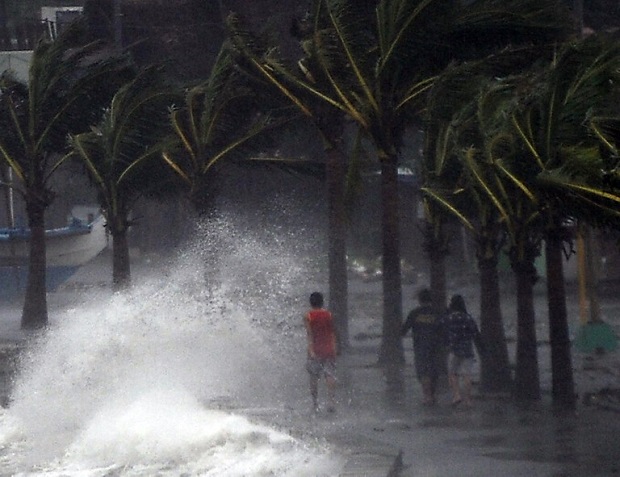No major damage as Ruby weakens

Residents walk past high waves brought about by strong winds as it pound the seawall, hours before Typhoon Hagupit passes near the city of Legazpi on December 7, 2014. Typhoon Hagupit tore apart homes and sent waves crashing through coastal communities across the eastern Philippines, creating more misery for millions following a barrage of deadly disasters. AFP PHOTO/TED ALJIBE
LEGAZPI, Philippines—Typhoon Ruby (Hagupit) knocked out power in entire coastal provinces, mowed down trees and sent more than 650,000 people into shelters before it weakened Sunday, sparing the central Philippines a repetition of unprecedented devastation by last year’s storm.
Shallow floods, damaged shanties and ripped off store signs and tin roofs were a common sight across the region, but there were no confirmed deaths or major destruction after Ruby slammed into Eastern Samar and other island provinces. It was packing maximum sustained winds of 140 kilometers (87 miles) per hour and gusts of 170 kph (106 mph), considerably weaker from its peak power but still a potentially deadly storm, according to forecasters.
The typhoon was moving slowly, which means more rainfall and a risk of landslides and flash floods.
Traumatized by Typhoon Yolanda’s (Haiyan) massive death and destruction last year in the central region that’s being partly whipped by Ruby, more than 650,000 people readily fled to about 1,000 emergency shelters and safer grounds. The government, backed by the 120,000-strong military, launched massive preparations to attain a zero-casualty target.
Rhea Estuna, a 29-year-old mother of one, fled to central Tacloban City’s evacuation center as early as Thursday and waited in fear as Ruby’s wind and rains lashed the school, where she and her family sought refuge. When she peered outside Sunday, she said she saw a starkly different aftermath compared to the horror of Yolanda’s aftermath.
“There were no bodies scattered on the road, no big mounds of debris,” Estuna told The Associated Press by cellphone. “Thanks to God this typhoon wasn’t as violent.”
Yolanda’s tsunami-like storm surges and killer winds left thousands of people dead and leveled entire villages, most of them in and around Tacloban.
Nearly a dozen countries led by the United States and the European Union have pledged to help in case of a catastrophe, disaster-response agency chief Alexander Pama said.
The EU commissioner for humanitarian aid, Christos Stylianides, said a team of experts would be deployed to help assess the damage and needed response.
“The Philippines are not alone as they brace up for a possible hardship,” Stylianides said, adding the European Commission was “hoping that the impact will be less powerful than a year ago when Typhoon Haiyan left a devastating imprint on the country.”
Authorities were verifying reports of some deaths but none has been confirmed so far, Pama told a news conference.
While officials expressed relief so far, they were quick to warn that Ruby was still on course to barrel across three major central islands before starting to blow away Tuesday into the South China Sea.
Several typhoon-lashed eastern villages isolated by downed telephone and power lines were out of contact, Welfare Secretary Dinky Soliman said.
“It’s too early to tell,” Philippine Red Cross Secretary-General Gwendolyn Pang said. “Let’s cross our fingers that it will stay that way. It’s too close to Christmas.”
Army troops deployed to supermarkets and major roads in provinces in the typhoon’s path to prevent looting and chaos and clear debris, all of which slowed the government’s response last year.
Unlike in past years, many people readily left high-risk communities now, Soliman said.
“Haiyan was the best teacher of all,” Soliman said. “People did not need much convincing to move to safety. In fact many of them volunteered to go.”
RELATED STORY
Palace thanks int’l community for Ruby aid














